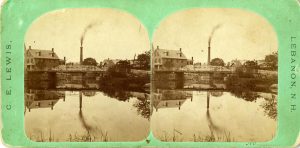
![]() Probably in the early 1880s, photographer C.E. Lewis produced this stereograph of the town of Lebanon, New Hampshire. Seen from the west bank of the Mascoma River, a smokestack spewing dark smoke is given pride of place. Like many New England towns located along rivers, Lebanon had long been the site of mills and manufacturing companies producing furniture, scythes, and especially textiles. Power was key—derived from dams that powered sawmills and then large-scale textile mills. Here we look toward the town’s lumber yard with its distinctive smokestack.
Probably in the early 1880s, photographer C.E. Lewis produced this stereograph of the town of Lebanon, New Hampshire. Seen from the west bank of the Mascoma River, a smokestack spewing dark smoke is given pride of place. Like many New England towns located along rivers, Lebanon had long been the site of mills and manufacturing companies producing furniture, scythes, and especially textiles. Power was key—derived from dams that powered sawmills and then large-scale textile mills. Here we look toward the town’s lumber yard with its distinctive smokestack.
Lebanon was also the home of C.E. Lewis, whose photography studio did a brisk business in portraits. In this stereograph he offers an unusual photographic portrait of his town, highlighting the relationship between the river and the mills it powered. Like the town of Middlebury, Lebanon developed a thriving woolen industry toward the end of the nineteenth century, staffed by a largely female workforce and aided by additional dams upstream. The woolen industry remained an important factor in Lebanon’s economy until the 1950s.

Unlike photographs such as John Pfahl’s views of nuclear power plants that have been termed examples of the “industrial sublime,” Lewis presents his industrial subject in picturesque harmony with nature. Reflected in the water, the smokestack’s emissions in Lewis’s photograph signal economic prosperity for a post-Civil war generation. Absent the anxiety attached to nuclear power in Pfahl’s scene, conveyed in the dark clouds looming over the reactor, Lewis’s scenic view ignores the environmental effects of bleaching and dying of fabrics in river water, as well as the air pollution generated by the town’s mills.
While numerous small-scale hydroelectric dams still exist on the river, the rail line that once services the town’s industries has now been converted in part to a “rail trail” bike path.